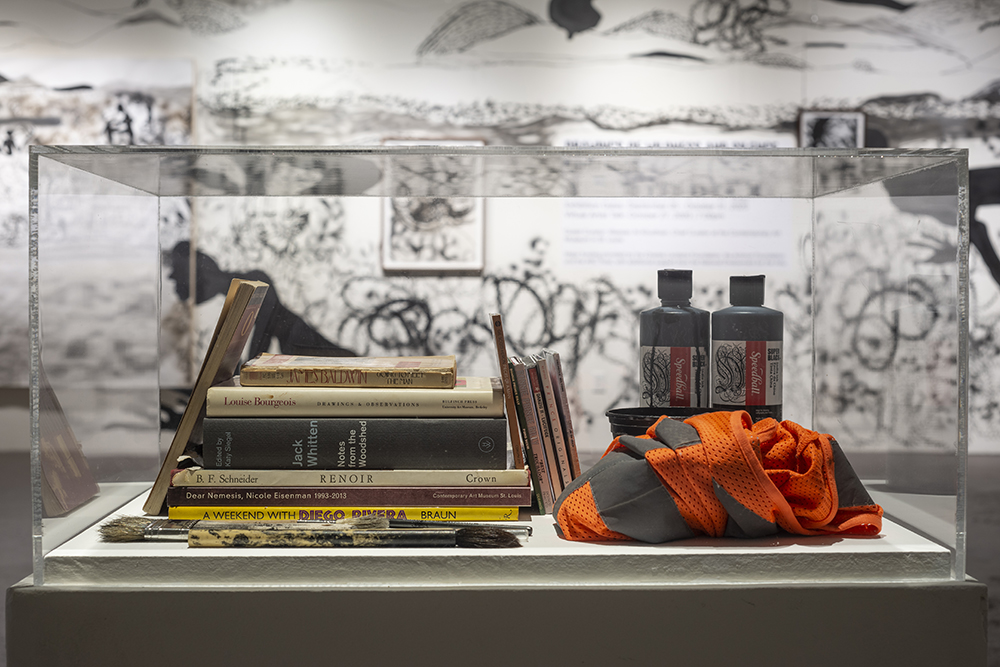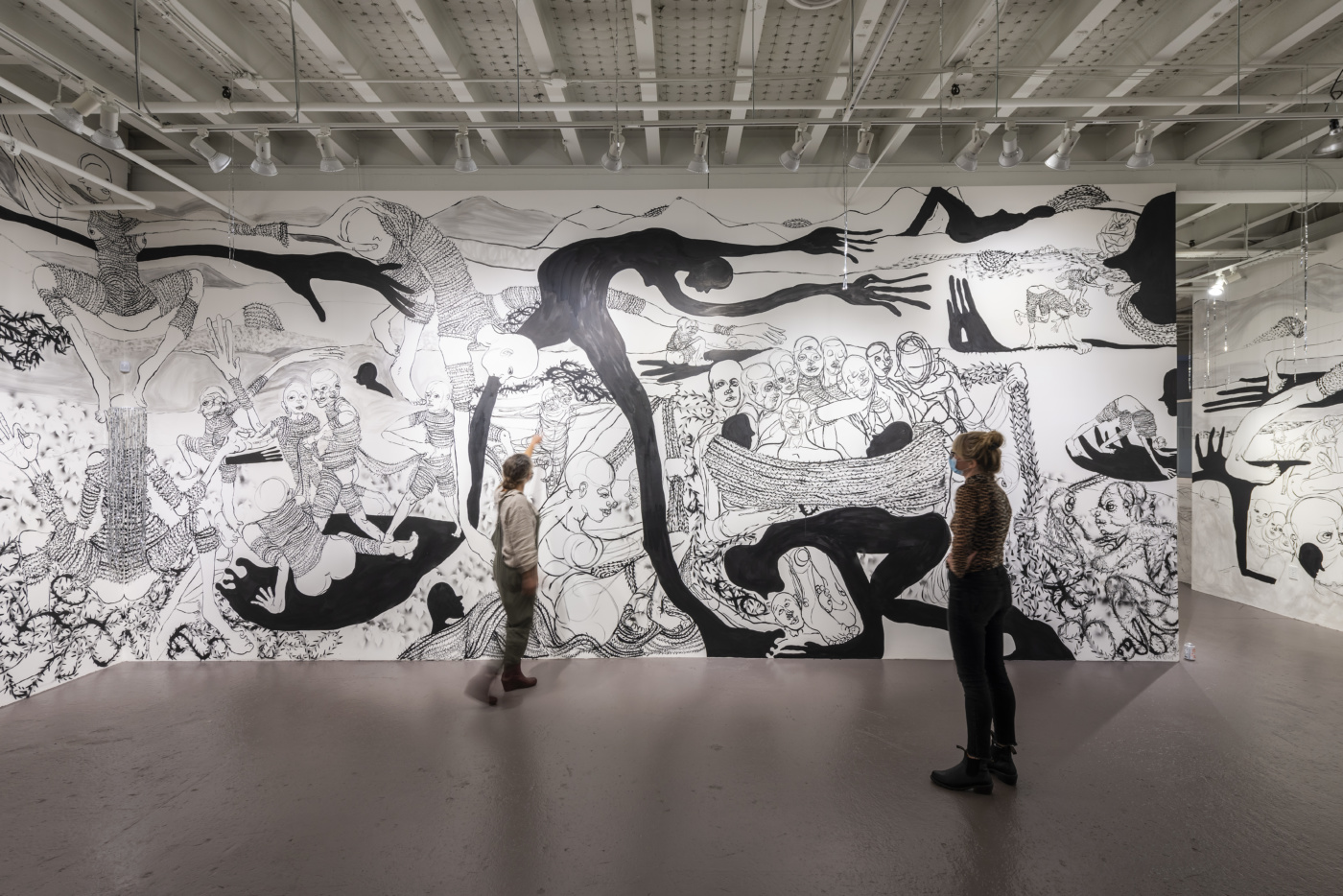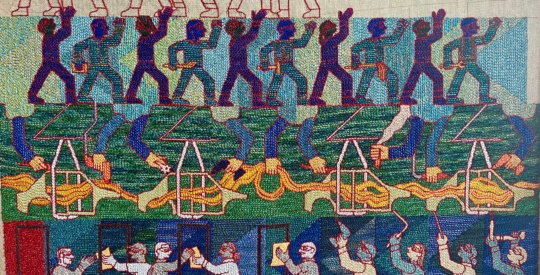
A monumental wall drawing interacts with several framed and mounted works on paper in William Downs’s Working Artist Project show, Drawings of Wildness and Silence, at the Museum of Contemporary Art of Georgia. The work engulfs you with its scale and transports you through its details. One can enter a state of reverie while looking, enjoying the intricacies and inventiveness of the composition, dwelling on the virtuosic use of line and shape. Piled up, interlaced, unraveling bodies; repeated and distorted human features; arid landscapes, fallen leaves, and barbwire. Downs achieves a startling amount of variety within the monochrome of his black ink medium: gestural lines, sprayed paint, solid black. Tinsel hangs from the ceiling and is integrated with the images. The drawings seem to fly out of Downs’s hand as the visual rendering of an unstoppable stream-of-consciousness. An underlying narrative keeps slipping away, morphing in front of your eyes.
One of the first pieces we approach as we enter the space is titled Black Riding Death Into the Future but Remembering the Past. It shows two recurrent figures in Downs’ work: Black and Death. The rider, Black, is a gestural line person whose head often contains more than one face. Black appears naked sometimes, and others dressed in a barbwire outfit, buttocks exposed. A solid black presence looms in different sizes and shapes throughout the exhibition. Black and Death enact an unfolding historical, political, and social drama. We see multitudes of people in different situations—casual, celebratory, and tortuous—everyone is equalized under the commanding shadows of Death.

A display case of personal belongings, lovingly arranged like a Fluxus box of found items, offers access into Downs’ artistic practice and influences. James Baldwin’s The Fire Next Time occupies a predominant spot among books about visual artists, CDs, brushes, bottles of black ink, and a bright orange construction worker’s vest. The book’s title comes from a Black American spiritual in which God promises fire if humanity does not reform after the flood, and this becomes a prophecy and warning in Baldwin’s book about racial injustice in the United States. Baldwin and Downs share a rolling, fluent, and complex style and an interest in examining religion. Scenes reminiscent of the Adoration, Noah’s ark, stigmata, and the descent from the cross are reinterpreted in Downs’s visual language, just as Baldwin grapples with Christianity and a Black Nationalist Islam in his text.
Downs reflects on race relations and the current moment through visual dialectics. In a corner we see a split figure, making the “OK” sign, also known as the mudra or the three-pointer hand gesture in basketball. According to a report from the Anti-Defamation League, in 2017 an online group from the messageboard 4chan started a hoax to rile up liberals, saying that the hand gesture is a pervasive symbol of white supremacy. The trolling effort was called “Operation O-KKK,” and it successfully stripped the hand gesture of its innocence when white supremacists and Trump supporters started using it with nefarious intent. Yesterday we considered this hand sign habitual and positive but today it is tainted. Racism surfaces on seemingly innocuous aspects of American life, leaving us with the question of what to do with our hands.

In Downs’s drawings, Black and Death appear in many forms, pushing and pulling, bending and flexing, helping and obstructing one another. In The Fire Next Time, Baldwin writes,
“It is the responsibility of free men to trust and to celebrate what is constant—birth, struggle, and death are constant, and so is love, though we might not always think so—and to apprehend the nature of change, to be able and willing to change.”
Both terrifying and poetic, the figure of Death looms large for Downs. It is not simply a morbid stand-in for the coronavirus pandemic or for the brutal racist acts and discourse of 2020. Drawings of Wildness and Silence is a complex, beautiful, celebratory, and grandiose show that reminds us to value life. It asks us to be responsible, to hold onto facts and reject lies. It tells us that we should not take for granted the health of this country, the world, the environment: we should remember mistakes of the past and change, now.
William Downs: Drawings of Wildness and Silence is on view at MOCA GA through October 31, 2020. Viewing is by appointment only. Please check MOCA GA for Covid-19 related precautions. Downs will deliver a virtual artist talk on October 27 at 7 pm EDT.




